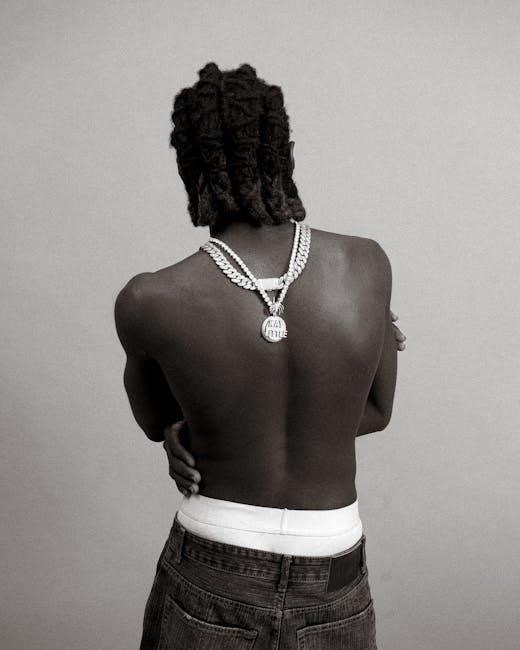A well-fitting belt is essential for both style and functionality. This guide helps determine the perfect belt size, ensuring comfort and confidence for every occasion.
Understanding the Importance of Proper Belt Fit
A proper-fitting belt is crucial for both style and functionality. It enhances your overall appearance while ensuring comfort and support. A belt that is too tight can cause discomfort, while one that is too loose may fail to hold your trousers securely. The right fit ensures your belt stays in place, supporting your pants without restricting movement. Whether for formal or casual wear, a well-sized belt complements your outfit and boosts confidence. Measuring accurately is key to avoiding common issues like sagging pants or an overly tight waistband. A perfect fit guarantees all-day comfort and a polished look.

How to Measure Your Waist for a Belt
To measure your waist for a belt, locate your natural waistline at the narrowest part of your torso and use a tape measure for accuracy.
Locating Your Natural Waistline
Your natural waistline is the narrowest part of your torso, typically just above the hipbone and below the ribcage. To find it, stand upright and relax your stomach. For most men, it’s where the belt naturally sits. If you’re unsure, wrap your fingers around your waist, and your thumb should point upward. This spot is ideal for measuring your waist size accurately. Ensuring you measure at this point guarantees the best fit for your belt, whether for formal wear, casual outfits, or workwear. Proper alignment is key to avoiding sizing errors.
Using a Tape Measure for Accurate Waist Measurement
To ensure an accurate waist measurement, stand upright and relax your stomach. Wrap a flexible tape measure around your natural waistline, keeping it level and parallel to the floor. Avoid pulling the tape too tight or leaving it too loose. The measurement should be snug but comfortable. This method provides the most precise reading for determining your belt size. Proper alignment and a relaxed posture are crucial for achieving an accurate measurement. This step is essential for selecting a belt that fits perfectly and enhances your overall look, whether for formal or casual wear.
Standard Men’s Belt Size Chart
This chart matches waist measurements to belt sizes, offering a quick reference for selecting the right belt. Belt sizes range from 28 to 50 inches.
Waist Size to Belt Size Conversion
To convert your waist size to belt size, add 2 inches to your natural waist measurement. For example, a 34-inch waist corresponds to a 36-inch belt. This rule applies to most styles, including formal and casual belts. When using pants size, the same principle applies—choose a belt size 2 inches larger than your pants size. For low-rise jeans or trousers, consider adding an additional 1-2 inches for comfort. Measure your waist at the narrowest point, typically just above the hipbone, to ensure accuracy. This method ensures a perfect fit, whether for workwear, suits, or everyday use.
Numeric Belt Sizes and Their Corresponding Waist Measurements
Numeric belt sizes are standardized to align with waist measurements, ensuring a consistent fit. A size 30 belt corresponds to a 28.5-inch waist, while a size 32 fits a 30.5-inch waist. Similarly, a size 34 belt matches a 32.5-inch waist, and a size 36 aligns with a 34.5-inch waist measurement. This pattern continues, with each increment in belt size accommodating an additional 1.5 inches in waist circumference. For example, a size 40 belt fits a 38.5-inch waist, while a size 42 corresponds to a 40.5-inch waist. This numeric system simplifies choosing the right belt size for both formal and casual styles.

How to Choose the Right Belt Size
Choosing the right belt size involves measuring your waist accurately, typically at the narrowest point above your hips. Use a tape measure to ensure accuracy, keeping it level and not too tight or loose. Belt sizes generally correspond to your waist size, but may require adding 1-2 inches depending on the style and fit desired. For example, a 34-inch waist might need a 36-inch belt. Consider the type of pants and belt style, as low-rise jeans may require a slightly longer belt. Refer to a size chart for precise pairing, as sizes can vary between brands. Ensure the belt is comfortable and fits the intended use, whether formal or casual.
Guidelines for Selecting the Perfect Belt Size
When selecting a belt, start by measuring your natural waistline at the narrowest point above your hips. Use a tape measure to get an accurate waist size in inches or centimeters. Compare this measurement to a standard belt size chart to determine the corresponding belt length. For example, a 34-inch waist typically corresponds to a 36-inch belt. If you prefer a tighter or looser fit, adjust accordingly. Consider the style of your pants and the belt’s intended use—casual, formal, or workwear—to ensure the best match. Always check the size chart provided by the manufacturer, as sizes can vary slightly between brands. This ensures the belt sits comfortably and functions properly, enhancing both your appearance and confidence. Additionally, if you’re purchasing a belt without trying it on, referring to a reliable size guide can help avoid sizing errors. By following these guidelines, you can confidently choose a belt that complements your wardrobe and personal style.
Considering Different Styles (Casual, Formal, Workwear)
When selecting a belt, consider the style of your outfit. For casual looks, such as jeans or low-rise pants, opt for a belt size 2-3 inches larger than your waist measurement. Formal events, like suits or dress pants, typically require a belt size closer to your natural waist size. Workwear or heavy-duty belts may need to be more durable and slightly longer for secure fastening. For example, a 34-inch waist might pair with a 36-inch belt for casual wear or a 34-inch belt for formal attire. Always refer to the specific style’s sizing recommendations to ensure the best fit and functionality.

Factors Influencing Belt Size
Your waist size, body type, and weight fluctuations significantly impact belt size. Even small changes in weight can affect fit, requiring adjustments to your belt size choice.
Waist vs. Hip Measurements
When determining belt size, distinguishing between waist and hip measurements is crucial. Your waist is the narrowest part of your torso, typically measured just above the belly button. In contrast, hip measurements are taken around the widest part of your hips and buttocks; For belts, focusing on waist size is more accurate, as belts are designed to sit at the natural waistline. If you prefer wearing your belt lower, consider hip measurements but note that this may require a slightly larger size. Accurate measurements ensure the best fit and comfort.
Weight Fluctuations and Their Impact on Belt Size
Weight changes can significantly affect belt size, as fluctuations alter waist and hip measurements. Gaining weight may require a larger belt size, while weight loss could necessitate a smaller one. Regularly measuring your waist ensures the best fit, especially during periods of weight change. If you experience frequent fluctuations, consider adjustable belts for versatility. Monitoring your size helps maintain comfort and style, ensuring your belt remains functional and fashionable regardless of weight changes.
Measuring an Existing Belt
To measure an existing belt, start from the top of the leather, excluding the buckle, to the middle hole. This length determines your ideal belt size.
How to Measure Your Current Belt for Size Accuracy
To measure your current belt accurately, start by locating the buckle and the middle hole. Lay the belt flat and measure from the top of the leather, excluding the buckle, to the middle hole. This length corresponds to your ideal belt size. For example, if the measurement is 36 inches, your belt size is 36. This method ensures a precise fit when purchasing a new belt. Always consider adding 1-2 inches to your pants size for the correct belt size, especially for jeans or low-rise styles. This guide helps you find the perfect fit every time.

Converting Pants Size to Belt Size
Convert your pants size to belt size by adding 2 inches for a comfortable fit. This adjustment ensures the belt sits perfectly, whether for jeans or workwear.
Using Your Jeans or Pants Size to Determine Belt Size
Converting your pants size to belt size is straightforward. If your pants have a 34-inch waist, opt for a 36-inch belt. For jeans or low-rise styles, add 3-4 inches to your waist size. This adjustment ensures the belt fits comfortably and securely. For example, a 32-inch waist in trousers translates to a 34-inch belt, while a 30-inch waist in jeans would require a 34-inch belt. This method provides a reliable way to find your ideal belt size based on your existing pants measurements, ensuring a perfect fit every time.
Where to Find Reliable Belt Size Charts
Popular brands like ASOS and Gucci offer detailed size guides on their websites. These charts provide accurate measurements and conversions for men’s belts, ensuring a perfect fit.
Popular Brands Offering Size Guides (ASOS, Gucci, etc.)
Leading brands like ASOS and Gucci provide comprehensive size guides to help men choose the perfect belt. ASOS offers detailed charts that correlate waist measurements with belt lengths, ensuring accuracy. Gucci’s official site includes specific sizing information for their belts, catering to both men and women. These guides often feature conversion charts, measurement tips, and style recommendations. By visiting these brands’ websites, you can access reliable tools to determine your ideal belt size effortlessly. Their resources are designed to simplify the selection process, ensuring a flawless fit for any occasion or wardrobe choice.
With accurate measurements and reliable guides, finding the perfect belt size is straightforward. Ensure a comfortable, stylish fit by referencing trusted charts and brand-specific sizing tools.
Final Tips for Ensuring the Best Fit
For optimal comfort and style, always measure your natural waistline accurately. Consider weight fluctuations and choose a belt slightly larger if you anticipate changes. Don’t rely solely on pants size, as belt sizes can vary. Test the belt by threading it through your pants loops to ensure it sits comfortably. For formal wear, opt for a narrower belt, while casual styles allow for wider options. Refer to brand-specific guides, like ASOS or Gucci, for precise fits. Remember, the belt should neither be too tight nor too loose, ensuring a secure and effortless look.
